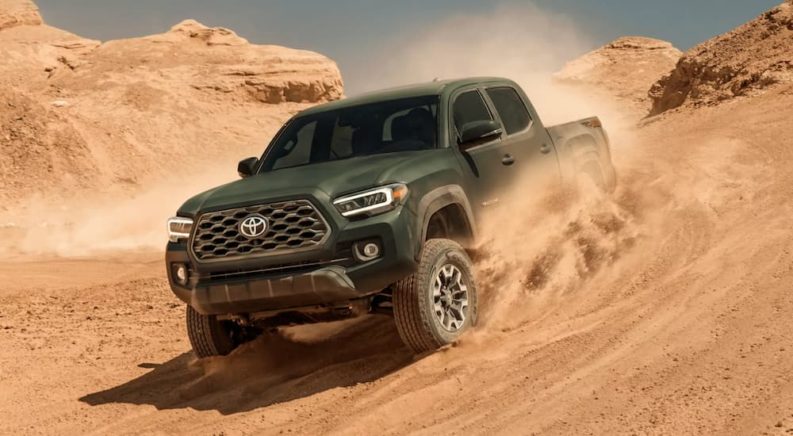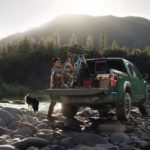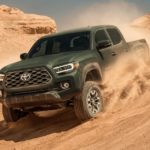Some people think cars are merely tools to get you, your family, and your stuff from Point A to Point B. This is a free country, so everyone is entitled to their opinion, but I would like to politely suggest that these people are hopelessly wrong and irredeemably lost. Luxury car comforts, sports car thrills, and off-roading independence transcend the basic transportation needs of the average person, yet they dominate the conversation because, at the end of the day, these things matter to people. Those who are incorrect about cars may scoff at many so-called “impractical” vehicles, but there are some designs that balance enjoyment with practicality so well that everyone can agree on their excellence. Such a marriage of form and function has made Toyota Tacoma dealers very happy for the last two decades!
At this point, who doesn’t know what a Tacoma is? For the longest time, it was the only viable option in the midsize pickup segment, hugely popular for offering unbeatable utility in a smaller package and with a lower cost of ownership than your typical F-150. It’s also built a reputation around the world, especially under the Hilux name, for being damn near indestructible and a perfectly capable off-roader with balanced suspension and a high, narrow stance perfectly suited for trailblazing.
TRD – More than a Track Car Division
Few Tacomas illustrate this better than those wearing the TRD badge. The Toyota Racing Development team may be more recognizable for off-roaders than on-road performance cars by now, as they feature so prominently in the Tacoma and Tundra trim level lineups. Could that be why Gazoo Racing is the new Toyota “sports car” label? Maybe; either way, TRD has demonstrated serious off-road chops with the TRD Sport, TRD Off-Road, and TRD Pro trims that have now been available on the Tacoma for years.
On the low end, TRD Sport is largely cosmetic, but it still features a V6 engine, a part-time 4×4 drivetrain, and an “automatic limited-slip differential.” With more than 9″ of ground clearance, it’s perfectly capable of handling many trails of moderate difficulty without modifications. At the other end of the spectrum is TRD Pro, with all of the bells and whistles, from a 1.5″/0.5″ front/rear lift to an off-road-focused camera system. I saw one such vehicle recently, equipped with an intake snorkel, and had the following conversation with my wife:
Me: “That snorkel means you can still get fresh air to the engine in deep water or other hazardous conditions.”
Her: “Why would you want that?”
Me: “So that you can drive in water up to your roofline!” (note: this is, of course, an exaggeration)
Her: “So, why would you want that?”
Me: “Because you can drive in water up to your roofline!”
Clearly, my wife falls into the category of lost automotive souls. Shame.
That being said, the TRD Pro is a bit much for the average driver. Fortunately, the TRD Off-Road trim level exists to provide a pleasant middle ground of cost and capability. It still gets multiple terrain drive modes, Crawl Control (a type of super-low-speed off-road cruise control), and a deleted front air dam for better approach angles. With all of that and more, TRD Off-Road comes off the lot with a genuinely healthy dose of capability at a palatable price.
In long-term testing, Edmund’s found this trim level to be quite satisfactory in terms of ride comfort thanks to the effective tuning of the suspension, which negates harsh jolts without bouncing all over the highway. A durable interior, composite truck bed, and the crawl control feature all won over their test drivers. While it isn’t for everyone, somebody who wants an off-road-ready vehicle will be hard-pressed to find one with more practicality or reliability than a TRD Off-Road Tacoma.
But There’s Another Way…
I am not particularly interested in investing time, energy, or money into working on a vehicle myself. It doesn’t come naturally, and my frustration at hiccups outweighs the satisfaction of a job well done, so I would shop for a TRD Tacoma if I were serious about doing a few years of regular off-roading. To those of you who are not like me and are reading this with oil-stained fingers:
- In many ways, I envy you for your interest and talent in this practical, potentially profitable hobby.
- Here are some thoughts on how you can beef up a Tacoma on your own, as reported to me by people like you.
Donut Media, a bunch of people who make YouTube videos about cars, spent four weeks modifying a pair of stock 2002 4×4 Tacomas, with one truck getting top-of-the-line upgrades and the other sticking to a tight budget. The point of the exercise is to identify whether the more expensive components are worth the extra cash compared to their budget counterparts.
To those of you who are curious about off-roading but haven’t done it, the biggest takeaway for the team–and for me–was that it’s more important to get out there and have fun than to spend a ton of money on the best possible vehicle. When it comes to off-roading, it’s better to work within the budget you have today and just go–even if that budget is $0 and you’ll be taking a stock 4×4 to the trails–than to waste precious time saving up to build the ultimate overlander. If you’ve got a 4×4 drivetrain, a locking differential, and all-terrain tires, you’ve got what you need to handle easy trails at least, so go have fun!
While all-terrain tires and locking differentials are essential, you don’t need to break the bank to get them. $200 tires and $100 steel wheels generated the same performance as $300 tires with $400 beadlock wheels on custom test grounds, the Imogene Pass leaving Telluride, and even climbing The Wall on the Poughkeepsie Gulch trail in Colorado. And while $4000 front and rear pneumatic diff lockers performed better than a single $800 factory electronic rear locker, it took the team three very long days to install, and they emphasized that it was more important to have any locker and then go have fun than to save up for a more expensive system that’s also harder to install.
Going the Extra Miles
Those are your essential features for tackling moderate terrain. Other modifications to consider for taking your off-roader to another level include:
- Lift kit
- Auxiliary lights
- Armor
- Recovery equipment
You could consider a lift kit or suspension upgrade to be essential, as it improves all of your off-roading metrics from ground clearance to approach, breakover, and departure angles while also allowing for larger, grippier tires. A $700 Bilstein suspension lift kit was comparable to a $3200 system in terms of off-roading benefits, so there’s no need to splurge if you just want to get out there, but definitely think about doing a lift before buying a full set of wheels and tires so you can make the most of it.
The other features listed here were all worth the extra cash in the eyes of the Donut team. An $80 “come-along” was just too much work to use compared to a $1200 winch, which was needed for the “High” truck to climb The Wall. Unfortunately, that team anchored the winch in such a location that the moment they reached the summit, the anchor was beneath the truck and the entire front bumper was ripped off – practice safe winching, kids! Besides that, traction pads were essential not only for the modified pickups, but also for the Jeep Wrangler camera crew vehicle following them up the mountain!
When it came to armoring the trucks to protect all their sensitive bits, the “Low” team tried to design all of their own bumpers, rock sliders, and skid plates with $800 of steel, nifty apps, and lots of geometry, but they ran out of time to finish it all. They still recommended taking that design-it-yourself approach (assuming you have the time and the tools) as it was a highly rewarding and educational experience, but the pre-cut skid plates used by the “High” team earned a favorable review as well. And finally, the classic look of KC Daylighters–and the high-quality light they dispersed into the desert darkness–were well worth the $2000 that the “High” team paid, even compared to the “value” of a $90 LED light bar.
Hitting the Sweet Spot
There’s very little that a Toyota Tacoma can’t do. Its size and strength make it an easy-going daily driver with room for friends and a sturdy work truck with respectable payload and towing abilities. Years of Toyota quality standards have made them dependable in the field and earned a reputation for holding value better than almost any other vehicle. With just a couple of specific features included, nearly any Tacoma is ready to head right from the dealer’s lot to rocky, muddy trails.
You’re probably somebody who understands that a vehicle is more than a tool to move you from A to B–it’s an experience, and a doorway to further experiences that you could never have on your own. A Tacoma in off-road-ready TRD trim or armed with DIY modifications opens many such doorways, walking a delicate line between utilitarian strength and frugal size and efficiency. As demonstrated by Tacoma’s long-term success, that’s a value package that we can all agree on.






